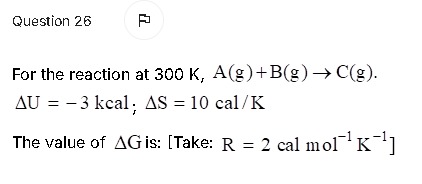Question
Question: For the reaction at 300 K, A(g)+B(g) → C(g). $\Delta$U = -3 kcal; $\Delta$S = 10 cal/K The value of...
For the reaction at 300 K, A(g)+B(g) → C(g). ΔU = -3 kcal; ΔS = 10 cal/K
The value of ΔG is: [Take: R = 2 cal mol−1 K−1]

-6.6 kcal
Solution
The Gibbs Free Energy change (ΔG) is related to enthalpy change (ΔH), temperature (T), and entropy change (ΔS) by the Gibbs-Helmholtz equation: ΔG=ΔH−TΔS The enthalpy change (ΔH) can be calculated from the internal energy change (ΔU) using the relation: ΔH=ΔU+ΔngRT where Δng is the change in the number of moles of gas in the reaction.
For the given reaction A(g) + B(g) → C(g): The change in the number of moles of gas is: Δng=(moles of gaseous products)−(moles of gaseous reactants) Δng=1−(1+1)=1−2=−1
Given values: Temperature, T=300 K Internal energy change, ΔU=−3 kcal Entropy change, ΔS=10 cal/K Gas constant, R=2 cal mol−1 K−1
To maintain consistency in units, we convert all values to kilocalories (kcal): ΔU=−3 kcal ΔS=10 cal/K=100010 kcal/K=0.01 kcal/K R=2 cal mol−1 K−1=10002 kcal mol−1 K−1=0.002 kcal mol−1 K−1
Now, calculate the enthalpy change (ΔH): ΔH=ΔU+ΔngRT ΔH=−3 kcal+(−1)×(0.002 kcal mol−1 K−1)×(300 K) ΔH=−3 kcal+(−0.6 kcal) ΔH=−3.6 kcal
Next, calculate the TΔS term: TΔS=(300 K)×(0.01 kcal/K) TΔS=3 kcal
Finally, calculate the Gibbs Free Energy change (ΔG): ΔG=ΔH−TΔS ΔG=−3.6 kcal−3 kcal ΔG=−6.6 kcal
